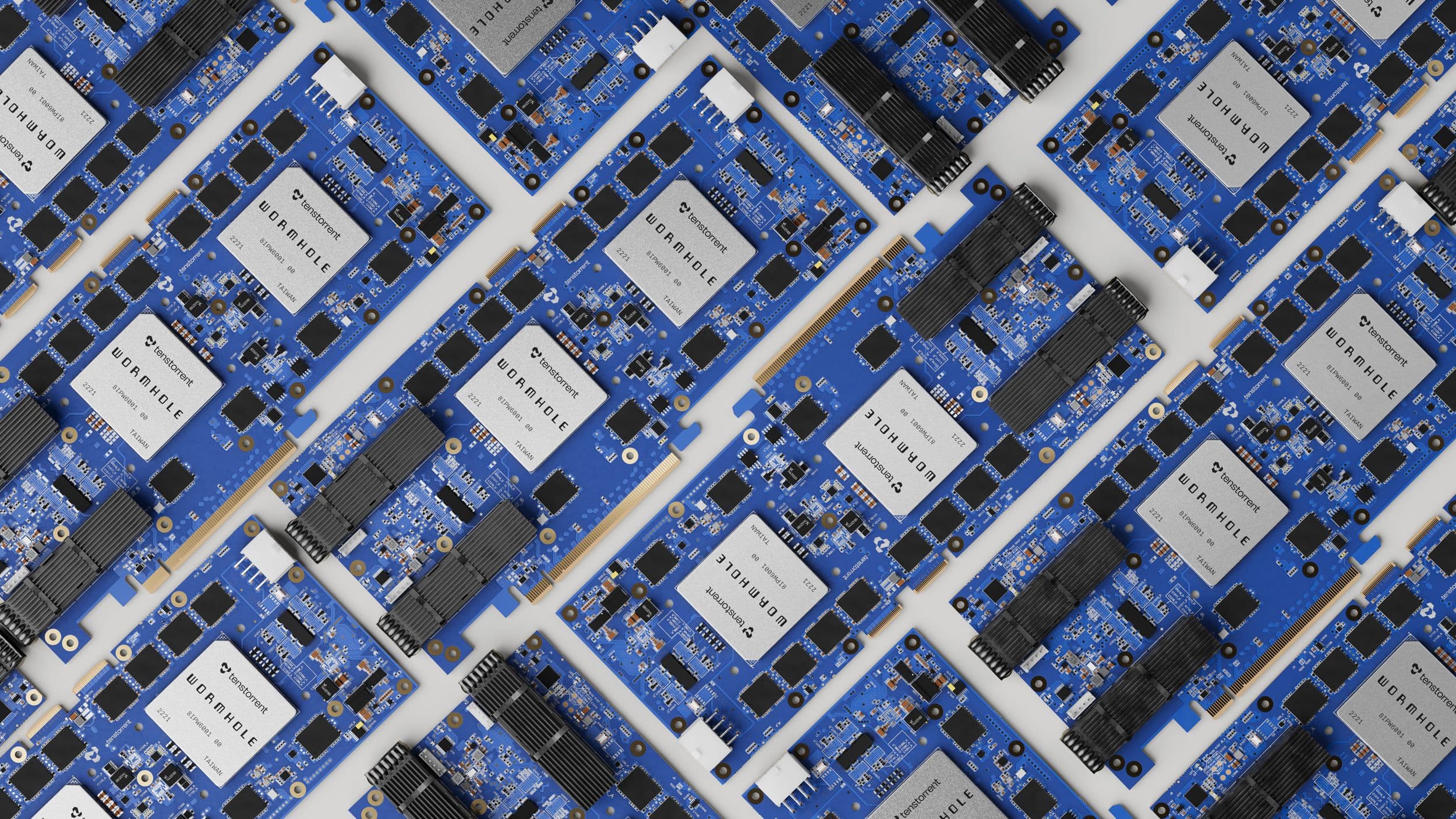Vision
Learnings, news, and updates from the Tenstorrent universe.

Announcements
Llama-3.1 Announcement
We are happy to announce that we have brought up support for Llama-3.1-70B inference on Tenstorrent’s 8-chip systems, the TT-QuietBox and the TT-LoudBox.

Announcements
Newsroom
Tenstorrent Launches Next-Generation Wormhole-Based Developer Kits and Workstations
Santa Clara, CA: Tenstorrent is launching their next-generation Wormhole™ chip featuring PCIe cards and workstations designed for developers who are interested in scalability for multi-chip development using Tenstorrent’s powerful open source software stacks.

Announcements
Newsroom
Tenstorrent and MosChip Partner on High Performant RISC-V Design
March 13, 2024 — Tenstorrent and MosChip Technologies announced today that they are partnering on design for Tenstorrent’s cutting-edge RISC-V solutions.

Announcements
Newsroom
Rapidus and Tenstorrent Partner to Accelerate Development of AI Edge Device Domain Based on 2nm Logic
SANTA CLARA, CA – Nov. 16, 2023 Rapidus Corporation, a company involved in the research, development, design, manufacture, and sales of advanced logic semiconductors, today announced an agreement with Tenstorrent Inc., a next-generation computing company building computers for AI, to jointly develop semiconductor IP (design assets) in the field of AI edge devices based on 2nm logic semiconductors.
Resources

AI Hardware w/ Jim Keller
Listen to Tenstorrent CEO Jim Keller discuss why AI models are graphs and how we built our software and hardware to give you a fundamental advantage at this year's AI Hardware Summit.

Designing in 2023: 10 Problems to Solve w/ Jim Keller
Tenstorrent President and CTO Jim Keller talked about designing for the future at TSMC's 2022 Open Innovation Platform Ecosystem Forum.

The Exciting Evolution of MLOps w/ Thaddeus Fortenberry
Tenstorrent Senior Principal Engineer Thaddeus Fortenberry discusses innovations in hardware through the lens of MLOps and model-based services
About Tenstorrent
Tenstorrent builds computers for artificial intelligence.
We design AI Graph Processors, high-performance RISC-V CPUs, and configurable chiplets that run our robust software stack.

Tenstorrent Team

Jim Keller
Chief Executive Officer
Jim Keller is CEO of Tenstorrent and a veteran hardware engineer. Prior to joining Tenstorrent, he served two years as Senior Vice President of Intel's Silicon Engineering Group. He has held roles as Tesla's Vice President of Auto...

Keith Witek
Chief Operating Officer
Keith Witek is currently the Chief Operating Officer of Tenstorrent leading operations, legal, HR, Finance, facilities, compliance, licensing, and other functions. Prior to joining Tenstorrent, Keith led all aspects of Strategic A...

Christine Blizzard
Chief Marketing Officer
Christine Blizzard is the Chief Marketing Officer of Tenstorrent. Prior to joining Tenstorrent she founded y3k, a brand marketing studio with a focus on the intersection of cutting edge technology and culture. y3k clients include ...

David Bennett
Chief Customer Officer
David Bennett is the Chief Customer Officer (CCO) of Tenstorrent Inc., a unicorn start-up that builds world-class AI, Machine Learning, and RISC-V technology. Since joining Tenstorrent in June of 2022, David has already led Tensto...

Stan Sokorac
Senior Fellow, AI Hardware & Software
Stan Sokorac leads the development of Tenstorrent’s high-performance AI processing unit, Tensix, which is the core IP component in Tenstorrent’s AI accelerators. He is also the lead for Tenstorrent’s open-source AI compiler, Buda....

Jasmina Vasiljevic
Fellow, ML, Compilers and Models
Jasmina Vasiljevic, a Senior Fellow at Tenstorrent, is at the forefront of the company’s mission to address the open-source compute demands for software 2.0. She leads the Pathfinding team, a group dedicated to exploring and devel...

Olof Johansson
VP of Operating Systems and Infrastructure Software
Olof Johansson is VP of Operating Systems and Infrastructure Software at Tenstorrent. Prior to Tenstorrent, Olof led software teams in Meta’s Infrastructure Hardware group, including ASIC FW/SW, OpenBMC and server enablement. Befo...

Julie Mathis
Senior Director of Product
Julie Mathis is the Senior Director of Product at Tenstorrent Inc. Tenstorrent is a North America-based unicorn startup that builds world-class AI, Machine Learning, and RISC-V hardware and software technology. She joined Tenstorr...

Dan Bailey
Senior Fellow, Lead of Physical Engineering
Dan Bailey leads Tenstorrent’s Physical Engineering team. Dan is well known in his field for physical design leadership and specifically for his designs of high-performance flip flops and new methodologies for global clock distrib...

Bob Grim
VP of Corporate Communications and Investor Relations
Bob Grim is the Vice President of Corporate Communications and Investor Relations at Tenstorrent, and currently co-leads fundraising activities as well as manages key sales accounts. Prior to this role, Bob was a founder and Chief...

Wei-Han Lien
Chief CPU Architect and Senior Fellow
Wei-Han Lien is a Chief Architect and Senior Fellow in Machine Learning hardware architecture. He is currently leading an architecture team in defining a high-performance RISC-V CPU, fabric, system caching, and high-performance me...

Tanya Bischoff
Senior Director of Operations and Strategic Partnerships
Tanya Bischoff is Senior Director of Supply Chain and Operations at Tenstorrent, with nearly two decades of experience shaping and optimizing supply chain operations. Recognized as one of Canada's top women to watch in the supply ...